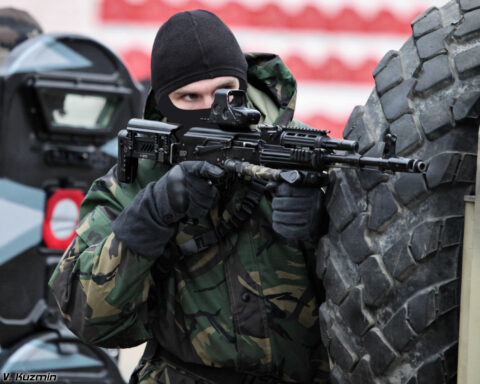Usually, when I’m considering a gun purchase, I consider what I will use it for. Will I hunt big game with it? Defend my family? Pest Control? You get the gist. The gun needs a reason to be added to the harem. When you consider what it is for, you have a sense of how it will be used. A .22 is for small game and plinking. A semi-auto in .22 is a perfect fit for knocking cans over or taking out a running jackrabbit. Sometimes, the cartridge itself is a factor in the type of firearm. This is the case with the Ruger American Rimfire chambered in .17 HMR. I picked one up a couple years ago.

The Cartridge
First, about the cartridge. The .17 HMR is a .22 magnum rimfire, necked down to take .17 caliber bullets. The result is a lightweight high velocity bullet that shoots a flat trajectory and carries a pretty good wallop out to 150 yards. The bullet is too small for bigger varmints, and loses velocity too fast for longer ranges. The wind also pushes the tiny bullet a lot. A couple years ago, Winchester introduced the 17 WSM. This cartridge is a nail gun blank adapted for the .17 caliber bullets. It is another giant leap forward, and if it had come out first, the .17 HMR would not have been as successful. It is what the .17 HMR should have been to start with. So if you think you need a rifle in your stable in this category, these issues should be considered. The problem with it is it may not catch on enough to survive, because the .17 HMR is well established, and the rifles chambered in .17 WSM are lackluster or expensive.
I like the 17 HMR. It is a fun cartridge to shoot. That is the category it fits in: Fun. It isn’t a serious cartridge for hunting coyotes or deer. The ammo costs more than .22 lr. That harms the fun factor, but only a little. You make up for higher ammo costs by hitting what you shoot at more often, and the results of a hit on a varmint are more certain, sometimes even spectacular. It will certainly kill a coyote, but if that was your intended quarry, you’d be better off with a centerfire. To sum up, the .17 HMR is a cartridge for small varmints and shooting, when precision and a little extra power is called for.
The Rifle
The model of .17 HMR that I owned had been recalled by the factory, so I had ammunition left over in a caliber that I enjoyed, but I didn’t have a rifle. Now, the problem with .17 HMR is that a good rifle costs as much as a centerfire. There is a Savage for about $200, but I didn’t like that one. Marlin makes a nice one, but I haven’t seen one in years and they cost too much, also. This is a fun cartridge, not a serious one, so if I’m spending serious rifle money, I should get a serious rifle. A new gunshop had opened up in town. I took my brother in law in to show him the AR’s. When we were just about to leave, something caught my eye in the used rifle rack.: “Ruger American .17 HMR. $260.” Now what is this? The dealer told me he had sold the gun new, and the guy traded it in after a week because his wife wanted a .204 AR, and she told him she needed that worse than he needed this gun. I told the dealer I needed a wife like that. 15 rounds through it. So I made a deal for $240. You can’t beat that. Finally a decent 17 HMR that I feel good about spending the money on. His price for a new one was $270.
This is a bolt action repeater that holds 9 in the magazine. Uses Ruger’s rotary magazines, just like the 10/22, only scaled up. It has an adjustable trigger, similar to Savage’s Acutrigger. The bolt is solid feeling. No binding. It isn’t as silky as a Tikka, but it is pretty smooth and has a substantial feel to it. I was loading a round once and bumped the mag release. The magazine fell out, but the round stayed on the bolt face even when I moved it forward and back. I wouldn’t call it controlled round feeding, but it is similar. Feeding, extraction and ejection were very positive feeling.
It has a fold down rear sight and a fiber optic front sight. I hate fiber optic sights; they usually are so big. This one I liked, and I liked the sight picture. You can get a pretty fine hold with them. Despite this, I couldn’t hit anything with the iron sights. I don’t think they were sighted in. No matter, this is not a rifle for irons. The stock is synthetic and comes with two inserts, one with a higher cheekpiece for using the iron sights. The stock is fairly solid feeling.
I took a set of rings off a .22 and mounted an old Weaver Grand Slam 4.5-14 that I had taken off my old .17 HMR. I think that is a pretty good choice for optics. It may seem silly to mount a scope that costs twice as much as the gun. Yet, the cartridge is capable of great precision, so higher magnification is in order. A smaller field of view isn’t a problem, You aren’t going to be swinging on a whitetail running through the trees. This is a cartridge you take your time to set up your shots with. Quality optics are called for, when the gun and cartridge are capable of making the most of it.
I got it dialed in quickly. The third shot hit dead on. I shot a five shot group. I didn’t measure, but it was around 1/2″ at about 40 yards. Not too bad for just screwing around and only trying one kind of ammo. The wind was blowing about 30 mph, so I didn’t try it at 100.
I proceeded to spend my Father’s Day shooting various varmints. I only missed once, when I hit a stick between me and my target. Since then, the rifle has served very well.
Pros: Bolt feel, magazine, looks OK, accurate, light weight, iron sights are functional, good trigger.
Cons: the magazine release sticks out a little, making it a little too easy to accidentally lose one. You have to bump it forward, though, to make it drop out. No wood stocked versions available, if that’s your thing.
The Ruger American Rimfire and the .17 HMR are a an excellent match. If Ruger ever offers this rifle in .17 WSM, I will need to upgrade. Otherwise, I’m very happy.
Ruger American Rimfire
2 Comments
Leave a Reply
Latest from Firearms

The Weimar Years – Part 5
Summary of the German Revolution, 1918-1919.

Ukraine, NATO, and the End of the Postwar Order
Russia is massing troops on the Ukrainian border. America is threatening sanctions or worse. Britain warns of war, while Germany wants peace. Is the post-WWII geopolitical order crumbling? Will Russia always be

The Commies Are Coming
The Commiecrats in congress have shifted their focus to gun grabbing. As they are writing their bill, and just a few days after a Colorado judge shot down a case that would
Molon Labe
Come and take it, you commie bastards.

One Night in San Antone: Ben Thompson (Part 2)
In the period now beginning, Ben drank more heavily than ever. He became a common nuisance to both his friends and his enemies; particularly perhaps, to his friends. Even his most indulgent


3
5